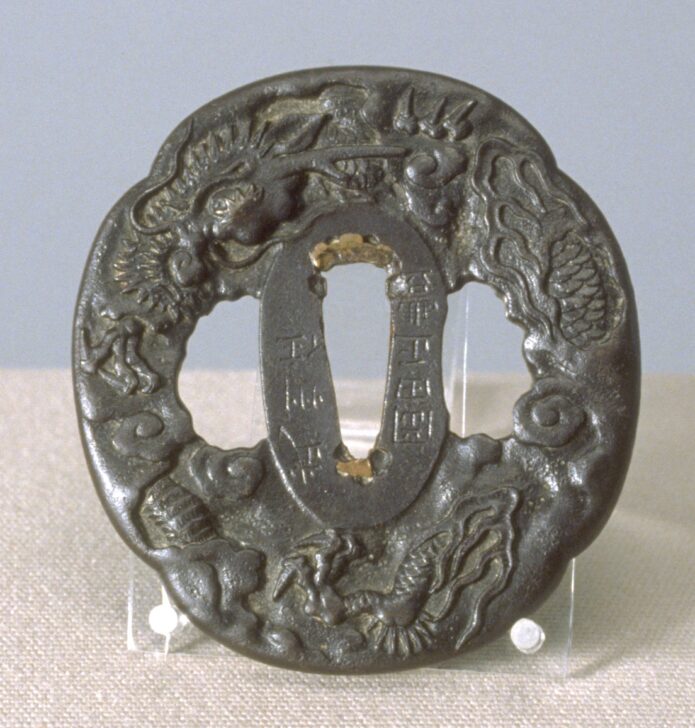Tsuba (Sword guard) with design of dragon among clouds
Okada Masatoyo

Description
Tsuba are intended to protect the user’s hand, first by shielding it against a blow from the opponent’s blade, and second by preventing it from slipping onto the razor-sharp edge of the weapon being wielded. Until the early seventeenth century, simply designed iron tsuba were dominant, as seen in the example here bearing a mushroom motif. When the Tokugawa regime required samurai warlords to travel regularly to the capital, Edo, and mandated that their wives and children reside there, considerations of urban fashion became more influential than battlefield practicalities in samurai attire and accessories. The tsuba became more an object of display than a functional item—a trend that further intensified when affluent merchants were permitted to carry swords in public and also began to demand attractive tsuba.
As is well represented by this collection, there was great artistic creativity at play in tsuba-making during the Edo period. The newly developed shakudô (a copper–gold alloy of a lustrous purple–black color) was used to create relief designs. Openwork chiseling was a versatile method for creating dramatic representations of family crests or light, airy, and elegant plant motifs.
(Label for UMMA Japanese Gallery Opening Rotation, March 2009)
Subject Matter:
Tsuba (sword guard) is inserted between a sword handle and blade to protect hands from sharp blades. The center hole is where the sword is placed. A smaller hole on the left is to place an ornamental stick, kozuka. Another hole on the right is to insert kougai, spatula-like sticks which are said to be used for itching hair underneath hats or helmets. The dragon is a popular motif in Eastern Asian culture. In Chinese tradition, the mythical creature is associated with the eastern direction and blue-green color. The dragon was also linked with water (oceans, rivers, mist and clouds), symbolizing the dark, wet, and nurturing female qualities of in-yô (Chinese: yin-yang) cosmology. Thus, the animal is often accompanied with some form of water; in this case, clouds. Japan took from China the habit of associating the dragon with the imperial institution, Buddhism, and the virtue of vigilance. (Reference: Baird, Merrily. Symbols of Japan)
Physical Description:
The flat iron plate with quatrefoil shape and the design of a dragon in midst of clouds. It has three holes: one for blade (middle) flanked by two deformed oval-shape holes (for kougai and kozuka). Around the blade hole, there is the carver’s signature. The design of a dragon, among stylized clouds, is intricately carved in high relief; the dragon has almost three-dimensional quality. On the back, the dragon tail, some parts of the body, one claw are peeking from clouds. The dragon coils around the center holes. The rims of the three circles are wavy, as if they are the part of the cloud design. The stoppers on the blade hole edges are made of gold. Some silver inlays are applied on the dragon’s eye blow and some nails.
Usage Rights:
If you are interested in using an image for a publication, please visit https://umma.umich.edu/request-image/ for more information and to fill out the online Image Rights and Reproductions Request Form.